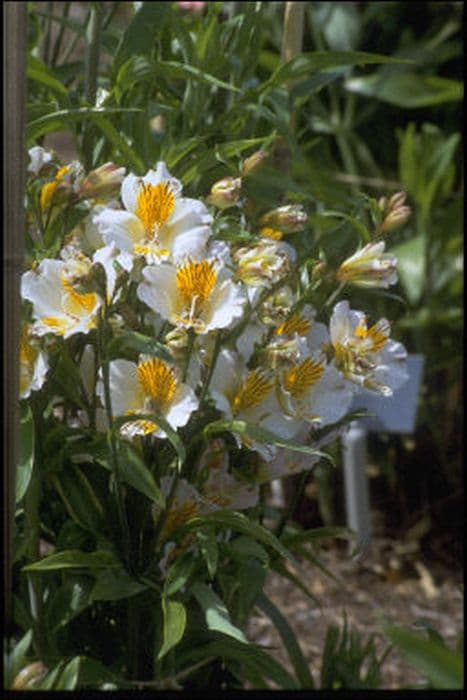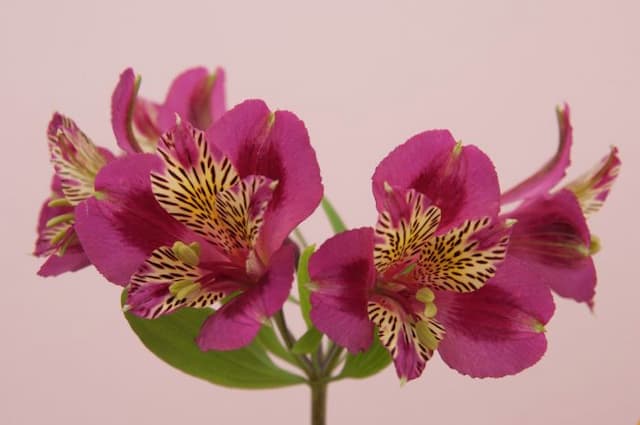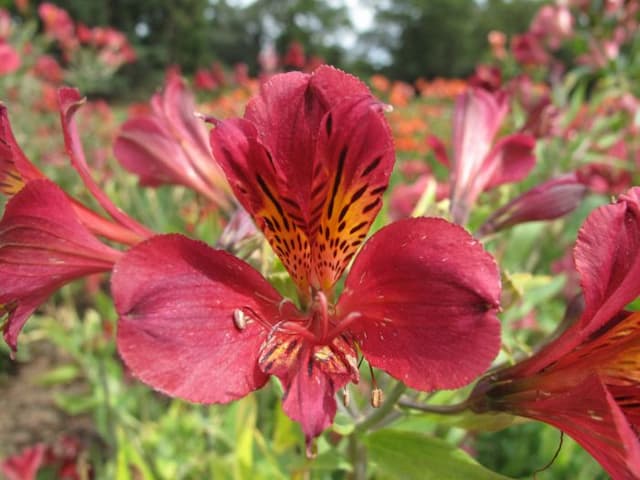Peruvian Lily Alstroemeria Summer Breeze = 'Teshunte' (PBR) (Summer Paradise Series)
![Peruvian lily [Summer Breeze]](/_next/image?url=https%3A%2F%2Fplants-admin.emdemapps.com%2Fimages%2Fplants%2F%2Fimages%2F604b6401573b7.png&w=3840&q=75)
ABOUT
Alstroemeria Summer Breeze, from the Summer Paradise Series, is a striking plant known for its vibrant colors and long-lasting flowers. This particular cultivar is adorned with eye-catching blooms that have a unique color scheme; petals exhibit a blend of bright yellows and intense pinks, often with streaks or flecks of darker hues that can be almost burgundy. The inner petal markings usually consist of decorative spots and dashes, adding to the intricacy of the overall floral display. The flowers themselves are trumpet-shaped and occur in clusters, creating a showy bouquet effect on top of the plant. Each blossom has six distinct petals, contributing to its symmetrical allure. The leaves that accompany these blossoms are lance-shaped, with a lush green coloration that serves as an excellent backdrop to the vivid flowers. Additionally, the foliage may have a slightly wavy or twisted appearance, providing texture and depth to the plant's overall look. It is important to note that this plant bears a resemblance to lilies in its flower shape and arrangement, making it an attractive addition to garden spaces and floral arrangements alike. The combination of the spectacular floral display and the verdant leaves creates a truly stunning specimen that can capture the eye and become a focal point wherever it is planted.
About this plant
 Names
NamesFamily
Alstroemeriaceae
Synonyms
Peruvian Lily, Lily of the Incas, Parrot Lily
Common names
Alstroemeria Summer Breeze 'Teshunte' (PBR) (Summer Paradise Series)
 Toxicity
ToxicityTo humans
Alstroemeria, commonly known as Peruvian lily, generally has a low level of toxicity to humans. It is not considered poisonous, and accidental ingestion often results in no more than mild gastrointestinal discomfort, such as nausea or diarrhea. However, handling the plant might cause skin irritation or an allergic reaction in some individuals due to its sap. It's important to wash hands after handling the plant and to avoid touching the face or eyes.
To pets
For pets, the Peruvian lily can be toxic. If ingested by cats or dogs, the plant can cause gastrointestinal symptoms including vomiting, diarrhea, and abdominal pain. Though the toxicity is generally considered mild to moderate, it is advisable to keep the Peruvian lily out of reach of pets, and if ingestion occurs, to monitor the pet and consult a veterinarian if symptoms persist or worsen.
 Characteristics
CharacteristicsLife cycle
Perennials
Foliage type
Deciduous
Color of leaves
Green
Flower color
Mixed
Height
2-3 feet (60-90 cm)
Spread
2 feet (60 cm)
Plant type
Herb
Hardiness zones
7
Native area
South America
Benefits
 General Benefits
General Benefits- Vibrant Flowers: Produces colorful, trumpet-shaped flowers that add visual appeal to gardens and landscapes.
- Long Blooming Season: Offers an extended blooming period from early summer to early autumn, providing long-lasting beauty.
- Attracts Pollinators: Blooms attract butterflies and hummingbirds, promoting pollination in the garden.
- Low Maintenance: Requires minimal care once established, making it ideal for busy gardeners.
- Cold Hardy: Resistant to cooler temperatures and can survive in USDA zones 7-10, suitable for a variety of climates.
- Drought Tolerant: Once established, it has good drought tolerance, reducing the need for frequent watering.
- Good Cut Flowers: Flowers have a long vase life, ideal for creating vibrant indoor floral arrangements.
- Non-Invasive: Unlike some other perennials, this plant is not known to be invasive, ensuring controlled growth in the garden.
 Medical Properties
Medical PropertiesThis plant is not used for medical purposes.
 Air-purifying Qualities
Air-purifying QualitiesThis plant is not specifically known for air purifying qualities.
 Other Uses
Other Uses- Photography Prop: The vibrant colors of Alstroemeria, also known as Peruvian lily, make them a popular choice for floral photography, giving a natural pop of color and texture to photo shoots.
- Art Inspiration: Artists can draw inspiration from the intricate patterns and hues of the Peruvian lily for paintings, textiles, and other art forms.
- Eco-Friendly Confetti: When dried, the petals of Peruvian lilies can be used as biodegradable confetti for celebrations, reducing environmental impact.
- Bookmarks: Dried Alstroemeria flowers can be pressed and laminated to create unique and personal bookmarks.
- Homemade Potpourri: Dried Peruvian lily petals can be mixed with other dried flowers and spices to create a naturally fragrant potpourri.
- Edible Garnishes: Although not widely known as an edible flower, the petals of Peruvian lily may be used as a colorful garnish on salads and desserts, after ensuring they're free from pesticides and chemicals.
- Floral Ice Cubes: Freeze small Alstroemeria blooms into ice cubes to add a touch of elegance to cocktails or punch bowls.
- Crafting: The stems and petals of the Peruvian lily can be incorporated into various craft projects, such as handmade paper or floral wreaths.
- Petal Pathways: Scatter fresh Alstroemeria petals along pathways for a special occasion to create a romantic, fragrant walkway.
- Greeting Cards: Pressed Alstroemeria flowers can be used to decorate handmade greeting cards or invitations, adding a 3D element.
Interesting Facts
 Feng Shui
Feng ShuiThe Peruvian Lily is not used in Feng Shui practice.
 Zodiac Sign Compitability
Zodiac Sign CompitabilityThe Peruvian Lily is not used in astrology practice.
 Plant Symbolism
Plant Symbolism- Friendship: Alstroemerias, commonly known as Peruvian lilies or lily of the Incas, often symbolize enduring friendships, as they have a long-lasting quality both as a cut flower and in friendships.
- Devotion: The twisted leaves of the Alstroemeria symbolize the winding and often complex nature of relationships, indicating a strong sense of devotion through life's twists and turns.
- Wealth and Fortune: With its multiple blooms on a stalk and lush appearance, the Alstroemeria can represent prosperity, wealth, and fortune, making it a good gift for new business ventures or wishing someone financial success.
- Mutual Support: As Alstroemeria blooms support each other in the bouquet, they symbolize the support shared between friends and loved ones, highlighting interdependence and teamwork.
 Water
WaterPeruvian Lilies require consistent moisture, so water them when the top inch of soil feels dry, typically once every week or two, but frequency depends on climate and soil type. Apply water slowly at the base of the plant to avoid wetting the foliage, which can promote disease. During hotter, dryer periods, you may need to water twice a week, providing at least 1 gallon per plant to ensure deep soil saturation. Reduce watering in the fall and winter months when the plant is not actively growing.
 Light
LightPeruvian Lilies thrive best in full sun to partial shade, making them well-suited for a spot that receives at least 6 hours of sunlight daily. However, in extremely hot climates, they benefit from protection from intense afternoon sun, so a location that offers morning sun with dappled afternoon shade is ideal.
 Temperature
TemperaturePeruvian Lilies, or Alstroemeria, prefer temperatures between 65 and 80 degrees Fahrenheit but can survive in temperatures as low as 23 degrees Fahrenheit and as high as 86 degrees Fahrenheit. They thrive in a moderate climate and can tolerate brief periods of colder or hotter temperatures, but prolonged extreme temperatures can be harmful.
 Pruning
PruningPrune Peruvian Lilies primarily to remove spent flower stalks and encourage further blooming. Cut back the flowering stems to the base after the blooms have faded. Pruning is also necessary to remove any damaged or diseased foliage. The best time for major pruning is late winter or early spring, just before new growth begins.
 Cleaning
CleaningAs needed
 Soil
SoilPeruvian Lily 'Summer Breeze' thrives in fertile, well-draining soil with a pH range of 6.5 to 7.5. Amend the soil with organic matter such as compost or peat moss to improve drainage and nutrient content.
 Repotting
RepottingPeruvian Lily 'Summer Breeze' typically needs repotting every 2 to 3 years. Choose a larger pot to accommodate root growth and refresh the soil mix to ensure optimal health.
 Humidity & Misting
Humidity & MistingPeruvian Lily 'Summer Breeze' prefers moderate humidity levels; ensure consistent moisture without making the air too damp to maintain its vibrant blooms.
 Suitable locations
Suitable locationsIndoor
Place in bright, indirect light with ample airflow.
Outdoor
Plant in partial shade; shelter from strong winds.
Hardiness zone
7-10 USDA
 Life cycle
Life cycleAlstroemeria Summer Breeze, commonly known as Peruvian Lily, begins its life as a rhizomatous tuber that sprouts in spring, developing into a clump of green, lance-shaped leaves. The plant quickly enters a vegetative stage where it produces sturdy stems that can reach up to 2-3 feet tall. Flowering occurs in midsummer, showcasing clusters of yellow and pink blooms that are attractive to bees and butterflies. After the flowering period, if blooms are regularly deadheaded, the plant can continue to produce flowers until early fall. As colder weather sets in, the above-ground foliage dies back, and the plant enters dormancy, conserving energy in its tuberous roots. With the return of warmer temperatures in the following spring, the cycle repeats as new growth emerges from the tubers.
 Propogation
PropogationPropogation time
Early Spring
Propogation: The most popular method of propagating the Alstroemeria Summer Breeze, also known as Peruvian Lily, is through division. This process is usually done in the spring before the growing season begins, or in the fall after the flowering period has ended. To propagate by division, carefully dig up an established clump of Peruvian Lily and gently separate the rhizomes by hand or with a clean, sharp knife, ensuring that each division has at least one or two growth buds. These divisions can then be replanted immediately at the same depth they were previously growing and spaced about 12 inches (approximately 30 centimeters) apart to allow room for growth. It is essential to water the new plantings adequately to help establish them, avoiding overly wet conditions that could lead to rot.
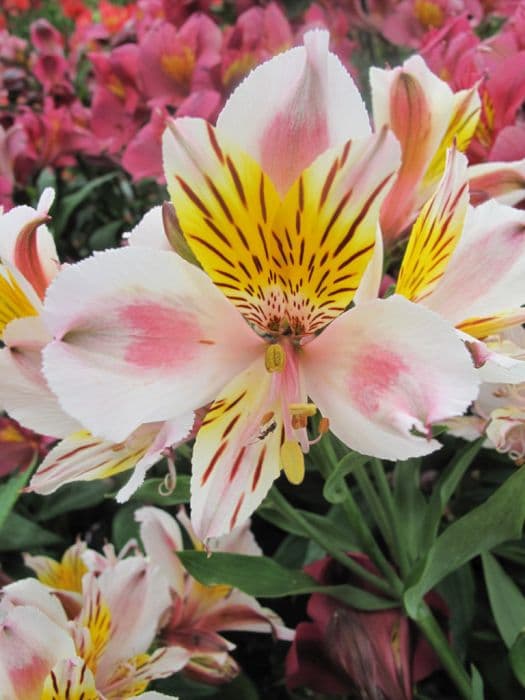
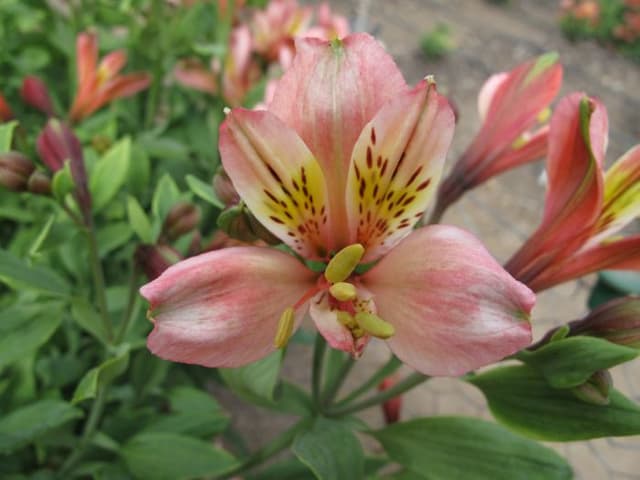
![Peruvian lily [Inca Glow]](/_next/image?url=https%3A%2F%2Fplants-admin.emdemapps.com%2Fimages%2Fplants%2F%2Fimages%2F604b5e99e48d9.png&w=640&q=75)
![Peruvian lily [Inca Smile]](/_next/image?url=https%3A%2F%2Fplants-admin.emdemapps.com%2Fimages%2Fplants%2F%2Fimages%2F604b5cad8fa91.png&w=640&q=75)
![Peruvian lily [Inticancha Passion]](/_next/image?url=https%3A%2F%2Fplants-admin.emdemapps.com%2Fimages%2Fplants%2F%2Fimages%2F604b5f7a78c8d.png&w=640&q=75)

